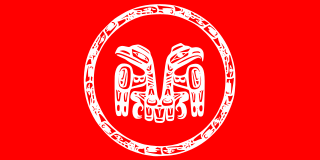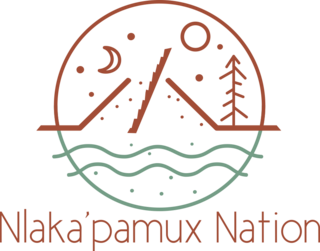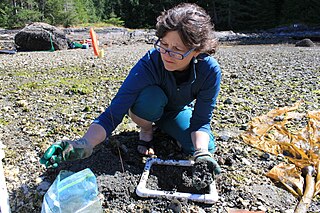
William Ronald Reid Jr. was a Haida artist whose works include jewelry, sculpture, screen-printing, and paintings. Producing over one thousand original works during his fifty-year career, Reid is regarded as one of the most significant Northwest Coast artists of the late twentieth century.

The Haida are an Indigenous group who have traditionally occupied Haida Gwaii, an archipelago just off the coast of British Columbia, Canada, for at least 12,500 years.

Haida Gwaii, also known as the Queen Charlotte Islands, is an archipelago located between 55–125 km (34–78 mi) off the northern Pacific coast of Canada. The islands are separated from the mainland to the east by the shallow Hecate Strait. Queen Charlotte Sound lies to the south, with Vancouver Island beyond. To the north, the disputed Dixon Entrance separates Haida Gwaii from the Alexander Archipelago in the U.S. state of Alaska.

The Royal British Columbia Museum, founded in 1886, is a history museum in Victoria, British Columbia, Canada. The "Royal" title was approved by Queen Elizabeth II and bestowed by Prince Philip in 1987, to coincide with a royal tour of that year. The museum merged with the British Columbia Provincial Archives in 2003.

Gwaii Haanas National Park Reserve, National Marine Conservation Area, and Haida Heritage Site, usually referred to simply as Gwaii Haanas, is located in southernmost Haida Gwaii, 130 kilometres off the mainland of British Columbia, Canada. Gwaii Haanas protects an archipelago of 138 islands, the largest being Moresby Island and the southernmost being Kunghit Island. "Gwaii Haanas" means "Islands of Beauty" in X̱aayda kíl, a southern dialect of the Haida language.
Sarah de Leeuw is a Canadian writer, researcher, and professor born in 1973. She has authored several publications, including "Unmarked: Landscapes Along Highway 16," "Frontlines: Portraits of Caregivers in Northern British Columbia," "Geographies of a Lover," "Skeena," and "Where it Hurts." De Leeuw grew up in British Columbia and has a diverse background, having worked as a tug boat driver, logging camp cook, and journalist. She earned a Bachelor of Fine Arts in creative writing from the University of Victoria and a PhD in cultural/historical geography from Queen's University. As a Canada Research Chair in Humanities and Health Inequities at the University of Northern British Columbia, her research focuses on colonialism in British Columbia, determinants of Indigenous health, and the impact of medical programs in northern and rural areas. Her work has been recognized with awards, including the CBC Literary Award for creative non-fiction and the Dorothy Livesay Poetry Prize. In 2017, she was inducted into the Royal Society of Canada.

Argentina pacifica, sometimes called pacific silverweed, silverweed cinquefoil, or simply silverweed, is a low-growing perennial (6") with pinnately compound green leaves with silvery undersides. It is a member of the species aggregate known as Argentina anserina or Potentilla anserina. The yellow, saucer-shaped flowers appear late spring through summer. Pacific silverweed spreads very quickly in moist areas. Preferring salt marshes, river estuaries and shorelines, they are often seen growing alongside springbank clover. They need sun and regular water.
Robert Charles Davidson, is a Canadian artist of Haida heritage. Davidson's Haida name is G̲uud San Glans, which means "Eagle of the Dawn". He is a leading figure in the renaissance of Haida art and culture. He lives in White Rock, British Columbia.

Cadboro Bay is a bay near the southern tip of Vancouver Island and its adjacent neighbourhood in the municipalities of Saanich and Oak Bay in Greater Victoria, British Columbia, Canada.
The Gitga'at are one of the 14 tribes of the Tsimshian nation in British Columbia, Canada, and inhabit the village of Hartley Bay, British Columbia, the name of which in the Tsimshian language is Txałgiu. The name Gitga'ata in the Tsimshian language means "people of the cane". The Gitga'ata, along with the Kitasoo Tsimshians at Klemtu, B.C., are often classed as "Southern Tsimshian," their traditional language being the southern dialect of the Tsimshian language. Most Tsimshian-speakers in Hartley Bay today, however, speak the form of the language shared by villages to the north. Their band government is the Hartley Bay Indian Band, aka the Gitga'at First Nation.
Wilson Duff was a Canadian archaeologist, cultural anthropologist, and museum curator.

The Indigenous peoples of the Pacific Northwest Coast are composed of many nations and tribal affiliations, each with distinctive cultural and political identities. They share certain beliefs, traditions and practices, such as the centrality of salmon as a resource and spiritual symbol, and many cultivation and subsistence practices. The term Northwest Coast or North West Coast is used in anthropology to refer to the groups of Indigenous people residing along the coast of what is now called British Columbia, Washington State, parts of Alaska, Oregon, and Northern California. The term Pacific Northwest is largely used in the American context.

SG̱ang Gwaay Llnagaay, commonly known by its English name Ninstints, is a village site of the Haida people and part of the Gwaii Haanas National Park Reserve and Haida Heritage Site on Haida Gwaii on the North Coast of British Columbia, Canada.
Annie Zixtkwu York was a distinguished elder of the Nlaka'pamux people of the Spuzzum First Nation of Spuzzum, in Fraser Canyon located in the lower region of British Columbia, Canada. York was raised by her Nlaka'pamux family where she came to be bilingual speaking English and Nlaka'pamuctsin. She dedicated herself to the Christian religion and the beliefs of the Nlaka'pamux people, Nle'kepmx. York's family members educated her about the history of Spuzzum as well as the origin of its name, Spuzzum chiefs, and the ethnobotany of the region. York was known to be a storyteller, always recording and sharing stories.

Viburnum edule, the squashberry, mooseberry, moosomin, moosewood viburnum, pembina, pimina, highbush cranberry, or lowbush cranberry is a species of shrub native to Canada and the northern parts of the US. It stands roughly 2 m (6.5 ft) tall with many stems and smooth branches.

The Nlakaʼpamux or Nlakapamuk, also previously known as the Thompson, Thompson River Salish, Thompson Salish, Thompson River Indians or Thompson River people, and historically as the Klackarpun, Haukamaugh, Knife Indians, and Couteau Indians, are an Indigenous First Nations people of the Interior Salish language group in southern British Columbia. Their traditional territory includes parts of the North Cascades region of Washington.

Dana Sue Lepofsky is a Canadian archaeologist and ethnobiologist. She is a professor at Simon Fraser University, a former president of the Society of Ethnobiology, and received the Smith-Wintemberg Award in 2018. Her research focuses on the historical ecology of the indigenous peoples of the Pacific Northwest Coast.

Terri-Lynn Williams-Davidson is a Canadian First Nations lawyer, artist, activist, and author and a member of the Raven Clan from the Haida Nation. As a lawyer, Williams-Davidson specializes in Indigenous and environmental law, having represented the Haida Nation at all levels of court since 1996 and notably participating in the litigation of the Haida Nation's TFL39 Case to protect the old-growth forests of Haida Gwaii, a case that effectively altered the government's stance on the consultation and accommodation of Aboriginal Rights.
Kung Jaadee is a traditional Haida storyteller, singer, drummer, teacher, and children's book author from the village of Old Massett, Haida Gwaii in Northern British Columbia, Canada.

Various Imperial and colonial actions against Haida Gwaii Authorities have been undertaken since the 19th century. The indigenous peoples of Haida Gwaii often reacted violently to European and American ships which trespassed in their waters and lands. From the 18th to 19th centuries, various skirmishes took place between Haida authorities and European and American merchantmen and warships. Canadian settlers did not arrive on Haida Gwaii islands until 1900, and many Canadian colonial police actions attempted to assault the Haida Gwaii authorities and citizens. The indigenous Haida population was decimated by diseases such as smallpox which were introduced accidentally by way of Fort Victoria. The presence of foreign diseases, to which the Haida had no immunity, along with some colonial hostility, meant that the numbers of Haida citizens was reduced from tens of thousands to 588 by 1915. This erosion of Haida cultural institutions was essential to open the way for subsequent British and Canadian incursions and jurisdictional claims.














